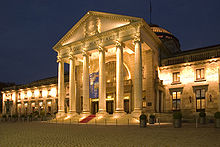Kurhaus
A spa house , also called a Kursaal , is a type of spa architecture from the 19th century. According to its function, it is a multi-purpose building. As a rule, it contains a representative entrance hall, plus a ballroom, theater and concert hall, games room and restaurants. In the bathing towns, it is often the most striking and representative building that marks the urban and social center of the health resort.
Well-known spa houses and course halls
Germany
- Altes Kurhaus Aachen , 1782–1786 by Jakob Couven
- Kurhaus Aachen ( Burtscheid ), 1887–1889 by Eduard Linse
- New Kurhaus Aachen , 1914–1916 by Theodor Fischer
- Kurhaus Baden-Baden
- Kursaal in Bad Brückenau , built in 1827, architect Johann Gottfried Gutensohn
- Kursaal Bad Cannstatt , Großer Kursaal built 1825–1841 by Nikolaus Friedrich von Thouret , Kleiner Kursaal 1907–1909 by Albert Eitel
- Kurhaus Bad Dürkheim
- Kursaal Bad Ems , rebuilt 1835–1839, architect Johann Gottfried Gutensohn.
- Kurhaus Bad Homburg
- Kurhaus Bad Honnef
- Regentenbau , arcade and foyer Bad Kissingen , connected complex, built 1834–1913, architects Friedrich von Gärtner and Max Littmann , largest spa buildings in Europe
- Kursaal Bad Lauchstädt , 1776–1780 by Johann Wilhelm Chryselius on behalf of the Elector Friedrich August III. of Saxony
- Kurhaus Bad Liebenzell
- Kurhaus Bad Oeynhausen
- Royal Kurhaus Bad Reichenhall , built in 1900, architect Max Littmann
- Kurhaus Bad Wildungen
- Kurhaus Bernburg , 1902
- Kurhaus Binz
- Kurhaus Freudenstadt , reconstruction in 1948 by city architect Ludwig Schweizer
- Kurhaus Göggingen in Augsburg-Göggingen , built in 1886 by Jean Keller
- Kursaal and Hotel in Helgoland , 1959, architects Friedrich Spengelin and Ingeborg Spengelin
- Kurhaus Schömberg
- Kurhaus Warnemünde in Rostock-Warnemünde, built 1914–1925 based on a design by Gustav Wilhelm Berringer and Walter Butzek
- Kurhaus Westerland
- Kurhaus Wiesbaden
Austria
- Kurhaus Semmering
- Kursaal Baden near Vienna, today Casino Baden
- Kurhaus Bad Ischl
- Kurhaus Bad Aussee
Switzerland
- Kursaal in Heiden , built in 1957 based on a design by Otto Glaus. The Kursaal Heiden project resulted from winning the architecture competition organized by the Heiden Kurverein in 1955. The building project envisaged a modern interpretation of the internationally renowned spa hall typology, according to which guests are offered entertainment and relaxation in a central location. The modern building replaced the now dilapidated previous building from 1874. After a renovation in the 1980s, the Kursaal was largely restored to its original state in 2009 and is now used as a seminar and congress center.
- Casino-Kursaal in Arosa , Switzerland, built in 1962 according to a design by Otto Glaus , later renovation of the facade by Alessandro Mendini
- Kursaal in Baden
- Kursaal in Bad Ragaz
- Kursaal in Bern
- Kursaal in Engelberg , built in 1902
- Kursaal in Interlaken
- Kurhaus in Cademario
- Kurhaus in Ascona
Belgium
- Kursaal in Ostend in Belgium. The architect of the first Kursaal building constructed from wood in 1852 was Hendrik Bevaert . In 1875 the building was demolished and completely rebuilt by Alban Chambon . Chambon gave the Kursaal the appearance of an oriental fairy tale palace. During the two world wars, the building was badly damaged due to military use. It was eventually to be demolished in favor of a new building by Norman Foster , which was largely rejected by the population. In 1998 the building was placed under a preservation order and restored under Patrick Verhamme .
Italy
- Kursaal in Rimini , 1843
- Kurhaus Meran , built in 1873, extended 1912–1914 according to plans by Friedrich Ohmann
- The Casinò Municipale, formerly Kursaal, in Sanremo is an Art Nouveau building from 1905 based on a design by the architect Eugène Ferret . The building, designed as a theater, was initially used for parties, receptions and concerts. The theater's ballroom was the venue for the Sanremo Festival from 1951 to 1976 .
- Kursaal in Arta Terme, built in 1975 based on a design by Gino Valle
- Kursaal in Lignano, Friuli
Estonia
- Kursaal in Haapsalu , built in the last years of the 19th century.
- Kursaal in Narva-Jõesuu , built 1911–1912.
- Kursaal in Pärnu , built in 1893.
Netherlands
- Kurhaus Scheveningen on the beach in Scheveningen, a district of The Hague
Spain
- Kursaal Auditorium, congress and music center in the Basque town of San Sebastián (Donostia). The glass palace was built in 1989–1999 based on a design by Rafael Moneo and in 2001 received the Mies van der Rohe Award for European Architecture . A Spanish film festival, the Festival Internacional de Cine de Donostia-San Sebastián, takes place in the Kursaal every year .
United Kingdom
- Kursaal in Southend-on-Sea , England. The area called Kursaal , established at the beginning of the 20th century, was Great Britain's first theme park. In 1970 the park was closed and the extensive area was used as a building area. The representative entrance building, which today serves as a casino and bowling alley, has been preserved.





